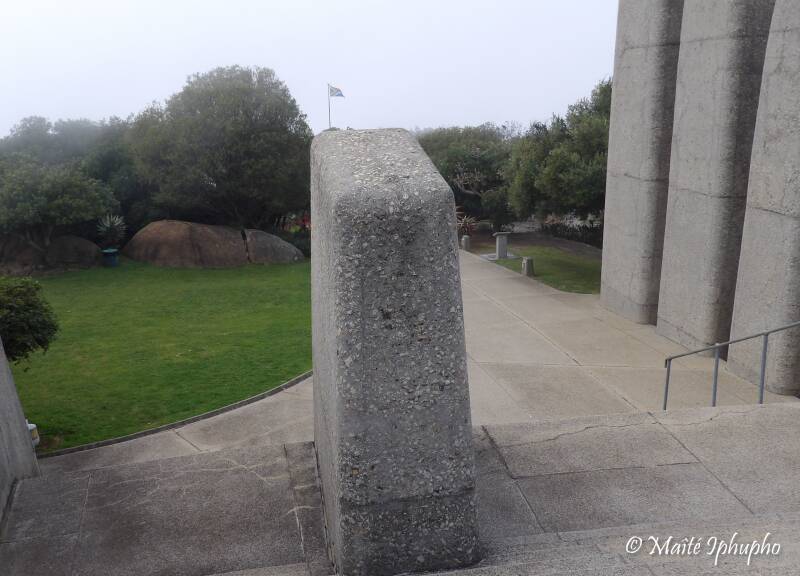Journey to the Heart of South African Culture: The Language Monument in Paarl!
When delving into the captivating history of South Africa, it quickly becomes apparent that the country has a deep-rooted connection with the Netherlands. It was Dutch merchants who established a supply post at the foot of Table Mountain. This historical bond has left behind a treasure trove of language that is still very much alive: Afrikaans. This language bears strong similarities to Dutch and is still spoken by descendants of the first Afrikaner settlers who made their home in the Cape Province. However, Afrikaans has undergone its own evolution and finds itself at the crossroads of tradition and change.
To pay homage to the Afrikaans language and truly understand why it is so special, you must venture to the Paarlberg in the town of Paarl. Here stands the impressive Afrikaans Language Monument, a tribute to the origins of Afrikaans in Europe, the influences of various European languages, and the growth of the language. The view over the Paarl valley from the monument is truly breathtaking. If you wish to delve even deeper into the history and development of the language, pay a visit to the Language Museum in the heart of Paarl during your journey through South Africa.

The Afrikaans Language Monument is not just an extraordinary structure. It is a testament to how deeply people value their Afrikaans language and culture. This monument is constructed in a modern style and demonstrates the extent to which people are committed to preserving and celebrating their language. What makes this even more special is that there are only two language monuments in the entire world, with the other one located in Burgersdorp, South Africa.
In the post-Apartheid era, Afrikaans and Afrikaners are facing a period of profound change. There is uncertainty about the preservation of Afrikaans in a world where English is gaining influence. Despite these challenges, Afrikaans remains the third most spoken language in the country, after Zulu (23%) and Xhosa (18%). Approximately 13% of the population considers Afrikaans their mother tongue. English ranks fifth at 9% and is widely used for communication.
DIT IS ONS ERNS, "We mean this." These words are inscribed in copper on the concrete path that leads up to the Afrikaans Language Monument.


The Language Monument, unveiled on October 10, 1975, marks a significant chapter in history. Designed by Jan van Wijk, this monument pays tribute to the rise and development of the Afrikaans language. As you stroll among the concrete pillars resembling open books, you can almost tangibly experience the rich heritage of South Africa's language and culture.
Although Afrikaans has its roots in Dutch, it has accumulated a rich blend of influences along the way. Words from Portuguese, French, and the Khoisan languages of South Africa's original inhabitants have intertwined with this language. And if you think the grammar is the same, you'd be mistaken. Afrikaans has given its own unique twist to the rules of Dutch.
The monument comprises various structures with both convex and concave elements, representing the influences of various languages and cultures on Afrikaans, as well as political developments in South Africa.
Here is a concise summary:

A-B-C represents the diversity of languages that have influenced Afrikaans:
A: European languages, with the tallest pillar rising to an impressive height of 13.5 meters.
B: Semi-circular rocks represent African influences on the language, including Khoi and other African languages.
C: Indonesian languages and dialects.
D & E reflect the inspiration Jan van Wijk drew from two Afrikaans writers:
D: The arches converge to form a bridge symbolizing the fusion of these diverse languages.
E: The imposing central pillar, reaching a height of 57 meters, symbolizes the growth and development of the language.
F places Afrikaans in the broader African context. A 26-meter high pillar is oriented northward to signify dialogue with the rest of Africa.
Finally, the fountain symbolizes the energy and purity of the Afrikaans language.
Will you join us on an adventure to uncover the language that makes South Africa so unique?
The Afrikaans Language Monument is not just a tribute to the past but also an invitation to embrace the rich history of language and culture, with a touch of Dutch connection.
Every journey to South Africa is an opportunity to explore the richness of local culture, and the Language Monument in Paarl is just one of the many treasures awaiting you in this beautiful country.












Add comment
Comments